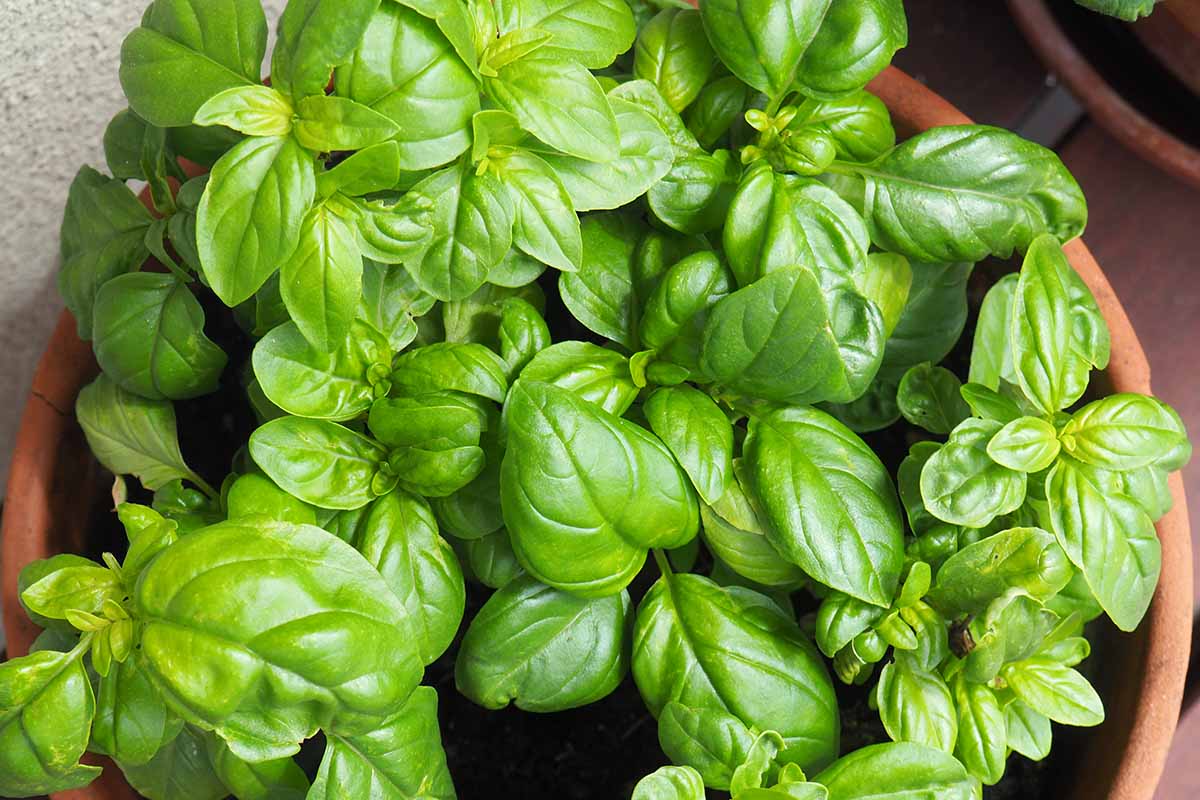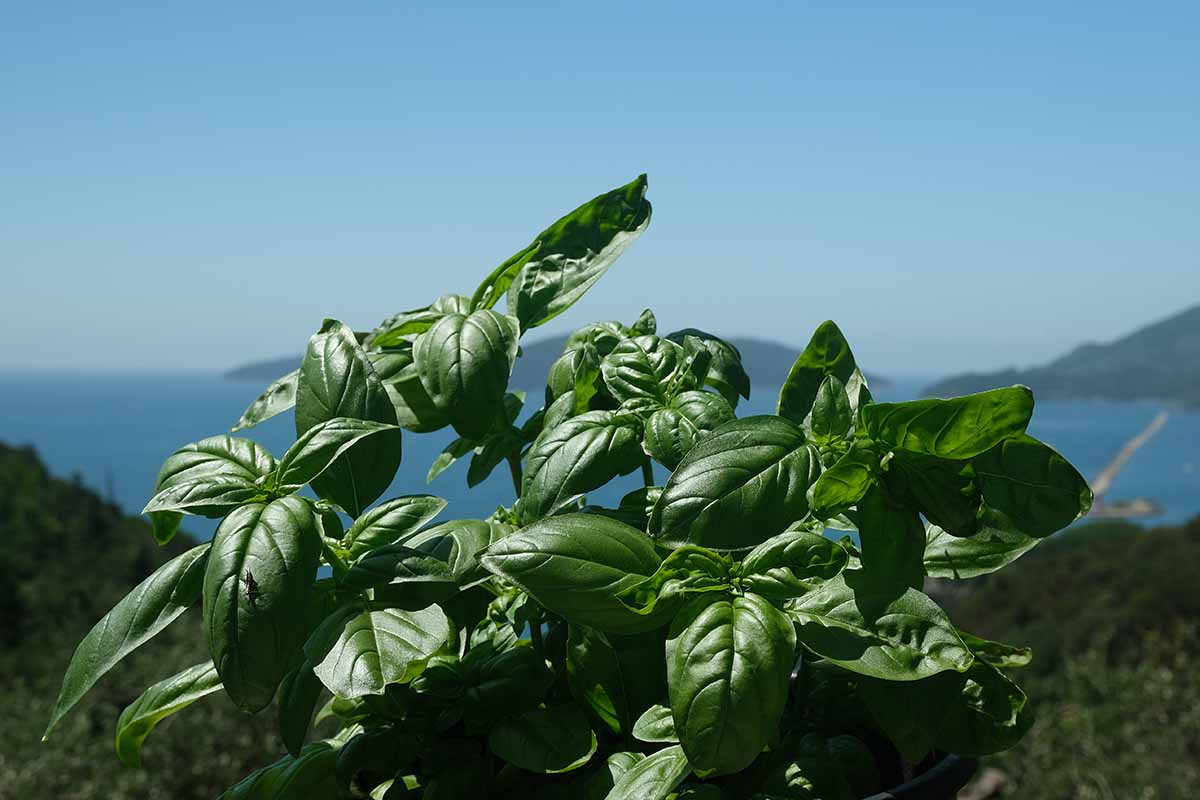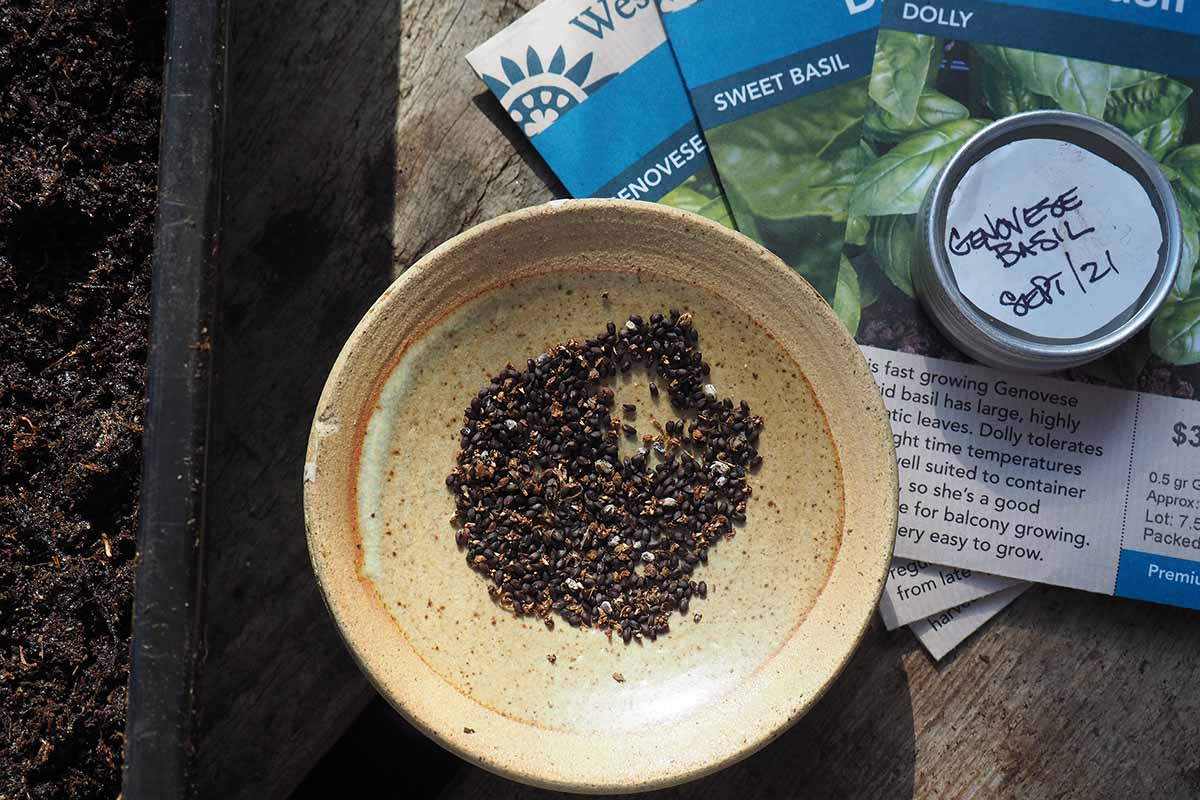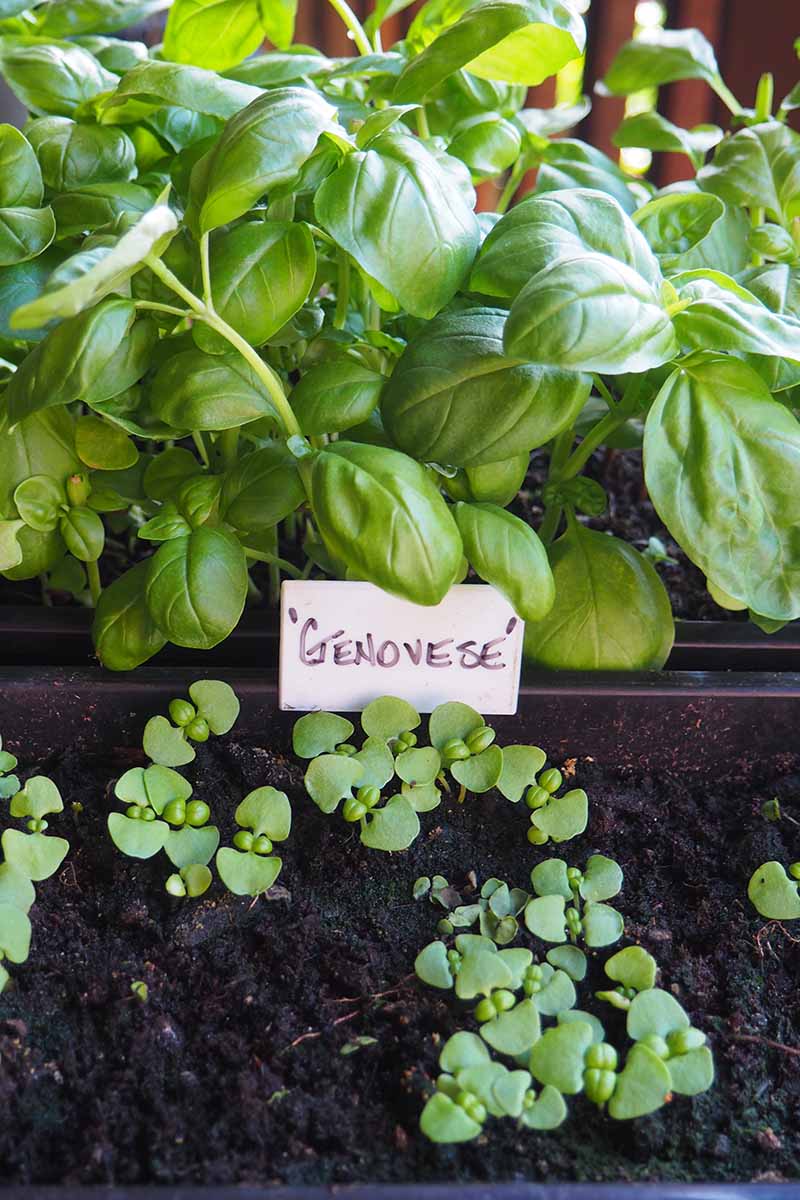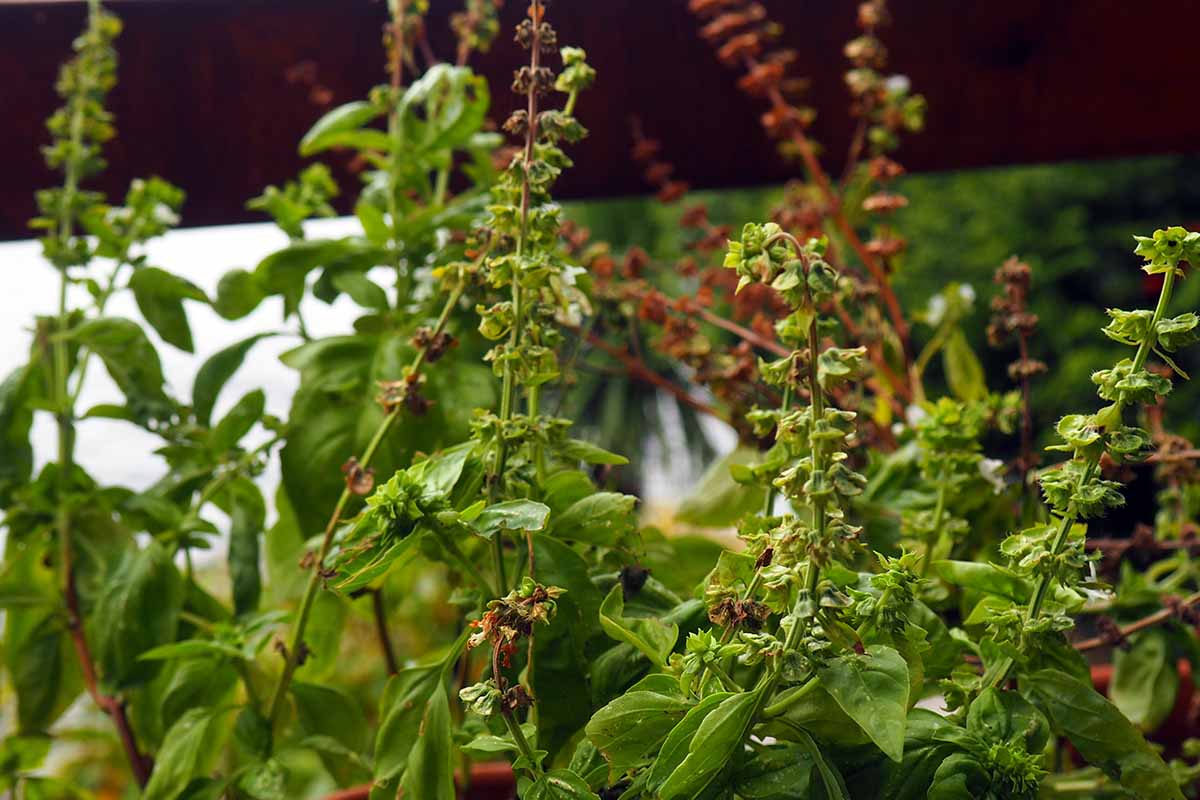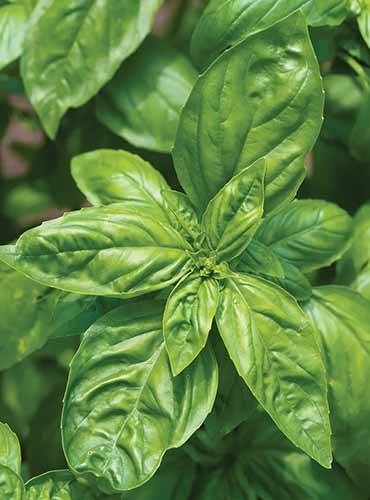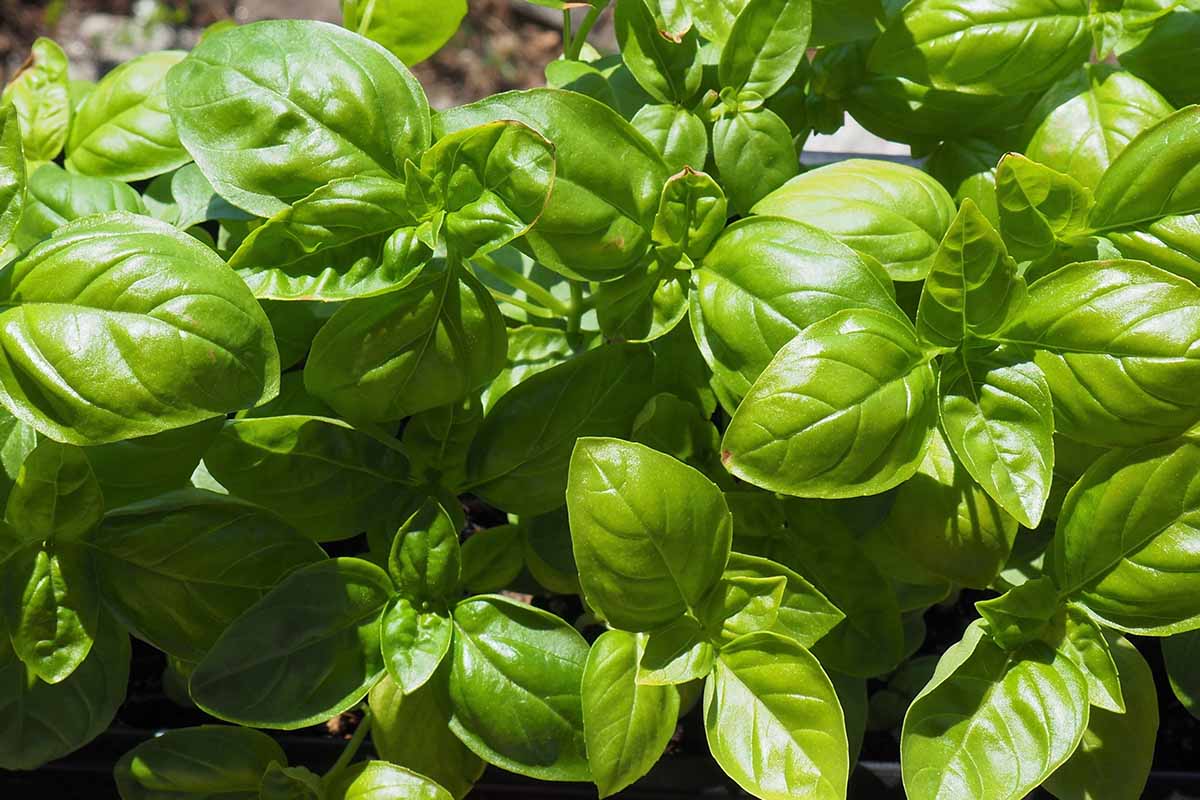It’s the traditional Italian herb used to create the very best pesto. This preferred variety has large, sweet leaves, is slow to bolt in extreme heat, and does not become bitter with age. We link to vendors to help you find relevant products. If you buy from one of our links, we may earn a commission. The fast-growing plants are frost-tender perennials, commonly grown as annuals. They are ideal for containers or garden beds in any sunny location. And the handsome, deep green leaves release a delightful, spicy fragrance when touched. Tall spires of white flowers are magnets for pollinators like bees, butterflies, and hummingbirds, and being an open-pollinated cultivar, seed collection produces plants true to the parent. It’s also a popular companion plant for vegetables and often used for its pest-repellent or flavor-enhancing properties with plants such as tomatoes, peppers, and root veggies like carrots. The superb flavor is a natural in many recipes other than pesto, including fish and seafood dishes, pasta, pizza, salads, sauces, and more. Plus, it retains flavor well when frozen. Fast-growing, flavorful, and fragrant, you’ll love this herb in your garden! Now, let’s dig into the easy steps on how to grow ‘Genovese’ basil. Here’s what we’ll cover:
What Is Genovese Basil?
Also known as heirloom, Italian, or traditional basil, ‘Genovese’ is a cultivar of the sweet species plant, Ocimum basilicum. A member of the mint (Lamiaceae) family, this aromatic culinary herb grows two to three feet in height and has large, tender leaves in rich shades of jade green with a bright, spicy-sweet flavor. The zesty taste includes notes of anise, cinnamon, cloves, and mint and the pretty plants emit an equally enticing fragrance when the leaves are touched. A frost-tender perennial, these plants are commonly grown as annuals and need warm weather to thrive – cool, moist conditions at 50°F and below can cause damping off, gray mold, and generally sulky behavior. But they can still be cultivated year-round by bringing in a pot before the first frost or starting new plants indoors over winter. However, they will still need at least six hours of strong light – and a simple, full spectrum grow light makes a continuous harvest easy. Thankfully, the days of glaring bare bulbs with an industrial wire clamp are long gone and there are plenty of attractive setups available for indoor cultivation – check out a few options in our guide to the best grow lights. Cold-hardy only in USDA Zones 10 and above, ‘Genovese’ is the star of the traditional green Italian sauce, pesto alla Genovese. And it’s also used in a wide variety of dishes as well as sauces and beverages, like eggs, fish and seafood, pasta, poultry, vegetable and tomato dishes, salads, smoothies, and vinaigrettes.
Cultivation and History
We naturally associate the ‘Genovese’ type with Italy, but the species originated in areas of Asia and Africa and made its way to the Mediterranean via the ancient spice routes. The flavorful plant was introduced to the Liguria region by the Romans who enjoyed an early version of pesto as a bread spread. Called moretum, it was prepared by crushing the leaves in a mortar with cheese, olive oil, and salt – sound familiar? Cultivated in Liguria for centuries, the cultivar name comes from the port city of Genoa. And the distinctive ‘Genovese’ flavor when grown there is said to be attributed to three key elements of the local terroir in the surrounding hillsides: the rich volcanic soils, lots of warm sunshine, and a sea breeze from the Mediterranean. Let’s look at how to bring a taste of the Italian Riviera into your own garden!
Propagation
‘Genovese’ is easily propagated by seeds or stem cuttings. An open pollinated (OP) cultivar, seeds produce plants true to the parent – so be sure to read our guide on how to harvest and save your own basil seed to preserve your own stock for planting. And for easy propagation steps, read this guide on how to propagate basil – it has all the details for starting plants from seeds and stem cuttings.
How to Grow
‘Genovese’ needs a full sun location and fertile, well-draining soil with a slightly acidic to neutral pH of 6.0 to 7.5. But the tender leaves don’t enjoy burning hot sunshine – provide light afternoon shade in areas with extreme summer heat. Amend garden beds and container soil with organic matter such as aged compost or well-rotted manure. And sprinkle in a bit of bone meal for strong roots. In beds and containers, the soil should be kept moist but not wet. For container plants, add a moisture-retentive material like coconut coir, peat moss, perlite, or vermiculite to resist drying out. Using a saucer under pots can also help hold onto moisture on hot summer days. Start seeds early indoors in small pots or trays and transplant your seedlings out once warm temperatures arrive. Successive crops can be started outdoors from late spring through summer. For germination and active growth, temperatures must be above 50°F. But the closer to 50°F the temperature is, the slower growth will be – basil really prefers warmer temperatures and thrives in the range of 70 to 90°F. Sow seeds half an inch deep and keep the soil moist for germination, which should occur in five to 10 days. When plants are four to six inches tall, pinch out the growing tips just above the second set of leaves. This encourages branching and bushy growth. Transplant into larger containers or garden beds after pinching out the tops. Also, to keep plants producing tasty leaves, pinch out the edible flower buds as they appear. But be sure to cut or pinch the stem below the buds – if only the bud tips are pinched, new ones reappear quickly. And depending on how much of an herbivore you are, successive plantings are a smart idea – because there’s nothing worse than running out! For a steady supply of leaves (and plenty for freezing), start a series of containers or short garden rows, sowing three or four weeks apart. Harvest the large leaves from the first pot or row, then move on and harvest the second, then third, and so on. As you continue to harvest successively, return to the earlier-picked plants for a second and third harvest. And if you do want to collect seeds, allow a few plants to flower freely. For a bountiful seed harvest, choose plants from an early crop. Seeds from later crops (sown from midsummer on) can still be green when a killing frost arrives, and ideally, you want them to ripen and dry in the late summer sun. Feed plants in garden beds and containers with a balanced fertilizer every three to four weeks. For indoor plants, feed less frequently, or every four to six weeks.
Growing Tips
The following tips will help produce an ample harvest:
For vibrant growth, wait until temperatures are consistently above 50°F before putting plants outdoors.Harvest frequently to prolong plant life and produce vigorous, bushy growth.Plant successively for an ample and steady supply of leaves.Keep the soil lightly moist but not wet.
And be sure to check our guide on how to grow basil for the best cultivation practices. Slugs and snails also enjoy this tasty herb in their diet. Locate plants in a full sun location to discourage visits and hand pick gastropods to dispose of them – or use one of the other solutions in our guide on how to protect your garden from slugs and snails. ‘Genovese’ You can find certified organic ‘Genovese’ seeds and plants at Burpee. Organic seeds in packets or in bulk are available at True Leaf Market. And large and small packets of organic, heirloom seeds are available at Botanical Interests. ‘Italian Large Leaf’ ‘Italian Large Leaf’ is another cultivar very similar to ‘Genovese’ with large, tender leaves. Seeds by the packet or in bulk are available at Eden Brothers. Or you can pick up ‘Italian Large Leaf’ plants in six-inch pots at Home Depot.
Managing Pests and Disease
‘Genovese’ is generally hearty, but a few common pests and diseases can be problematic. Sap-sucking aphids can damage the stems but these can be carefully knocked away from sturdy plants with a strong spray of water. An insecticidal soap or neem oil can be used for dense infestations. Fusarium wilt (Fusarium oxysporum f. sp. basilicum) is a common fungal problem along with damping off (Rhizoctonia solani) and gray mold (Botrytis cinerea). Ensure clean, sterile soil is used to prevent the spread of soil-borne pathogens like fusarium wilt. Give plants adequate air circulation and a warm environment to avert conditions like gray mold and damping off.
Harvest and Storage
Once plants are about six inches tall, nip stems just above the second set of leaves to encourage branching and bushier plants. After that, pinch off the end growth from the longest stems as desired. These pruning practices help your herbs to thrive, but they double as proper harvesting techniques! Fresh ‘Genovese’ basil is always best, but leaves retain their flavor well when frozen. And although they do darken in color and become a little mushy after freezing, they’re great for adding flavor to sauces, soups, stews, and other cooked dishes. Our guide on how to freeze herbs has all the steps you’ll need.
Recipes and Cooking Ideas
For an unmistakable taste, add fresh ‘Genovese’ leaves to salads, sandwiches, and smoothies. Or mix some into your favorite herb vinaigrette. This herb makes any tomato dish wonderful. It gives a bright flavor to eggs, fish and seafood, pasta, and veggies, and adds depth to sauces, soups, and stews. And for an authentic, rich flavor, try it in this classic Italian pesto recipe from our sister site, Foodal. Experiment a little and you’ll discover your own favorite uses for this tasty cultivar. Fast-growing and wonderfully rewarding, start seedlings early indoors and then move them to a sunny spot in the garden when reliably warm temperatures arrive. But be warned, you’ll harvest these tasty leaves as fast as they grow – so plant successively throughout summer for a continuous supply! How do you folks like to use ‘Genovese’ basil? Tell us about it in the comments section below. And for even more options to enjoy delicious basil at home, read these guides next:
13 Favorite Basil Varieties for the GardenTips for Growing ‘Sweet Dani’ Lemon Basil in Your Herb GardenHow to Grow Thai Basil in Your Herb Garden

